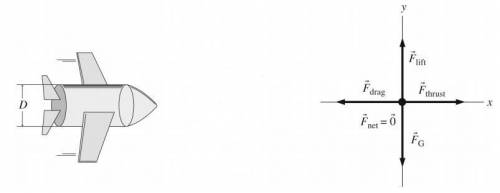
Engineering, 06.03.2020 21:57 kevenluna10oytivm
A medium-sized jet has a 3.8-m-diameter fuselage and a loaded mass of 85,000 kg. The drag on an airplane is primarily due to the cylindrical fuselage, and aerodynamic shaping gives it a drag coefficient of 0.37. How much thrust must the jet’s engines provide to cruise at 230 m/s at an altitude where the air density is 1.0 kg/m3?

Answers: 1


Another question on Engineering

Engineering, 03.07.2019 14:10
Amass of 1.5 kg of air at 120 kpa and 24°c is contained in a gas-tight, frictionless piston-cylinder device. the air is now compressed to a final pressure of 720 kpa. during the process, heat is transferred from the air such that the temperature inside the cylinder remains constant. calculate the boundary work input during this process.
Answers: 2

Engineering, 03.07.2019 23:20
Two technicians are discussing the intake air temperature (iat) sensor. technician a says that the computer uses the iat sensor as a backup to the engine coolant temperature (ect) sensor. technician b says that the powertrain control module (pcm) will subtract the calculated amount of fuel if the air measures hot. who is correct
Answers: 3

Engineering, 04.07.2019 18:10
Acompressor receives the shaft work to decrease the pressure of the fluid. a)- true b)- false
Answers: 3

Engineering, 04.07.2019 18:10
Fluids at rest possess no flow energy. a)- true b)- false
Answers: 3
You know the right answer?
A medium-sized jet has a 3.8-m-diameter fuselage and a loaded mass of 85,000 kg. The drag on an airp...
Questions

Biology, 20.11.2020 01:00


Advanced Placement (AP), 20.11.2020 01:00

Computers and Technology, 20.11.2020 01:00

History, 20.11.2020 01:00


Mathematics, 20.11.2020 01:00

Mathematics, 20.11.2020 01:00



Social Studies, 20.11.2020 01:00


Social Studies, 20.11.2020 01:00

Mathematics, 20.11.2020 01:00




Mathematics, 20.11.2020 01:00

Mathematics, 20.11.2020 01:00




